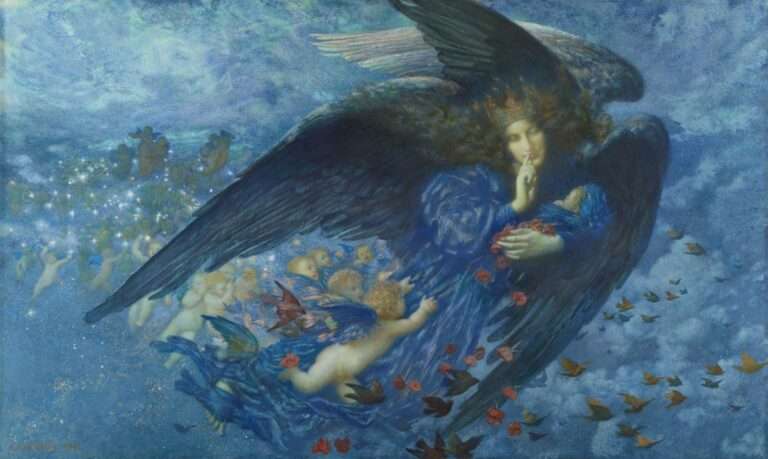Decoding the Meaning: Conceptual Art Symbolism
Conceptual art is a form of art that prioritizes the idea or concept behind the artwork rather than the physical object itself. It emerged in the 1960s as a reaction against traditional art forms and sought to challenge the notion of what art could be. Symbolism, on the other hand, refers to the use of symbols or symbolic elements in art to convey meaning or evoke emotions. It is a powerful tool that artists use to communicate complex ideas or concepts.
The history of conceptual art and symbolism can be traced back to the early 20th century with artists like Marcel Duchamp and his readymades. Duchamp’s Fountain, a urinal signed with the pseudonym “R. Mutt,” challenged traditional notions of art and raised questions about the role of the artist and the value of art. This marked a shift towards a more conceptual approach to art-making.
The Role of Symbolism in Conceptual Art
Symbolism plays a crucial role in conceptual art as it allows artists to convey their ideas or concepts in a more abstract or metaphorical way. By using symbols, artists can communicate complex thoughts or emotions that may be difficult to express through traditional means. Symbolism also adds depth and layers of meaning to an artwork, inviting viewers to engage with it on a deeper level.
Many conceptual artists use symbolism in their work to explore themes such as identity, politics, and social issues. For example, Joseph Beuys, a prominent figure in conceptual art, often used symbols like animals, felt, and honey in his performances and installations to address themes of healing, transformation, and spirituality. These symbols were not chosen randomly but were carefully selected for their inherent meanings and associations.
The significance of symbolism in conceptual art lies in its ability to transcend language barriers and cultural differences. Symbols have universal meanings that can be understood by people from different backgrounds and cultures. This allows conceptual art to communicate ideas and concepts that are relevant and relatable to a wide range of audiences.
Decoding the Meaning: Understanding Symbolism in Conceptual Art
Decoding symbolism in conceptual art can be a challenging task as it requires careful observation, research, and an understanding of the artist’s intentions and context. One technique for decoding symbolism is to analyze the visual elements used in the artwork. This includes examining the choice of symbols, colors, composition, and other visual cues.
Research and context are also crucial in understanding symbolism in conceptual art. Artists often draw inspiration from various sources such as literature, mythology, history, or personal experiences. By researching these influences, viewers can gain a deeper understanding of the symbols used and their intended meanings.
For example, in Ai Weiwei’s installation “Sunflower Seeds,” the artist used millions of porcelain sunflower seeds to cover the floor of a gallery space. On the surface, it may seem like a simple and visually striking installation. However, by understanding the historical and cultural significance of sunflowers in Chinese culture, viewers can interpret the artwork as a commentary on mass production, individuality, and censorship.
The Use of Metaphors in Conceptual Art
Metaphor is another powerful tool used in conceptual art to convey meaning or evoke emotions. In art, a metaphor is a figure of speech that compares two unrelated things to create a new meaning or association. It allows artists to express abstract or complex ideas through visual representation.
Conceptual artists often use metaphors to challenge conventional thinking or to explore philosophical concepts. For example, in René Magritte’s famous painting “The Treachery of Images,” which depicts a pipe with the words “Ceci n’est pas une pipe” (This is not a pipe) written below it, the artist challenges our perception of reality and questions the relationship between an object and its representation.
Metaphors in conceptual art can be subtle or overt, depending on the artist’s intentions. They can be found in the choice of objects, materials, or even in the composition of the artwork. By using metaphors, artists can create layers of meaning and invite viewers to engage with the artwork on a deeper level.
The Power of Color in Symbolism
Color is a powerful tool used in art to convey emotions, create visual impact, and communicate meaning. In conceptual art, color symbolism is often used to enhance the message or concept behind the artwork. Different colors have different associations and can evoke specific emotions or moods.
For example, red is often associated with passion, love, or anger, while blue is associated with calmness or sadness. By using these colors strategically, artists can enhance the intended meaning of their artwork. In Yves Klein’s “Blue Monochrome” series, the artist used a specific shade of blue called International Klein Blue to create a sense of depth and spirituality.
Color symbolism in conceptual art can also be subjective and open to interpretation. The same color may evoke different emotions or associations for different viewers based on their personal experiences or cultural backgrounds. This adds another layer of complexity to the decoding process and invites viewers to engage with the artwork in a more personal and subjective way.
The Importance of Context in Decoding Symbolism

Context plays a crucial role in decoding symbolism in art. The meaning of symbols can vary depending on the cultural, historical, or social context in which they are used. Without understanding the context, it can be challenging to fully grasp the intended meaning behind an artwork.
For example, Frida Kahlo’s self-portraits are filled with symbols that reflect her personal experiences and Mexican culture. Symbols such as monkeys, thorns, and broken columns are used to convey her pain, struggles, and identity as a Mexican woman. Without understanding Kahlo’s personal history and the cultural context in which she lived, it would be difficult to fully appreciate the symbolism in her artwork.
Similarly, contemporary conceptual artists often create artworks that are influenced by their immediate surroundings or current events. By understanding the context in which the artwork was created, viewers can gain a deeper understanding of the symbols used and their intended meanings.
The Role of the Viewer in Interpreting Symbolism
In conceptual art, the viewer plays a crucial role in interpreting symbolism. Unlike traditional art forms where the meaning is often fixed or predetermined by the artist, conceptual art invites viewers to actively engage with the artwork and contribute their own interpretations.
The same piece of art can be interpreted differently by different viewers based on their personal experiences, beliefs, or perspectives. This subjective interpretation adds depth and richness to the artwork and allows for multiple layers of meaning.
For example, in Damien Hirst’s “The Physical Impossibility of Death in the Mind of Someone Living,” a shark preserved in formaldehyde is presented as an artwork. Some viewers may interpret it as a commentary on mortality or the fragility of life, while others may see it as a critique of consumerism or the commodification of art. The artist’s intention may have been different from these interpretations, but it is ultimately up to the viewer to make meaning out of the artwork.
The Connection between Conceptual Art and Philosophy
Conceptual art and philosophy have a close relationship as both seek to explore abstract ideas, challenge conventional thinking, and question the nature of reality. Many conceptual artists draw inspiration from philosophical concepts or use philosophy as a framework for their work.
For example, Sol LeWitt’s “Paragraphs on Conceptual Art” is a seminal text that outlines the principles and ideas behind conceptual art. In this text, LeWitt discusses concepts such as the dematerialization of art, the importance of ideas over objects, and the role of the artist as a facilitator rather than a creator. These ideas are deeply rooted in philosophical concepts such as phenomenology, existentialism, and poststructuralism.
Conceptual artists often use philosophy to inform their work and to explore complex ideas or concepts. By incorporating philosophical concepts into their artwork, they can challenge traditional notions of art and provoke intellectual and philosophical discussions.
The Evolution of Symbolism in Conceptual Art
Symbolism in conceptual art has evolved over time, reflecting the changing cultural, social, and political landscape. In the early days of conceptual art, symbolism was often used to challenge traditional art forms and to question the role of the artist and the value of art.
As conceptual art evolved, symbolism became more nuanced and complex. Artists began to explore themes such as identity, gender, race, and social issues through symbolic representation. They used symbols to convey hidden meanings or to create visual metaphors that invited viewers to engage with the artwork on a deeper level.
The influence of different art movements on conceptual art symbolism is also evident. For example, in the 1980s, during the height of postmodernism, artists like Barbara Kruger and Jenny Holzer used text and language as symbols to critique consumerism, patriarchy, and power structures. Their artworks were often displayed in public spaces, challenging the traditional boundaries of the art world.
The Impact of Conceptual Art Symbolism on Contemporary Art
The impact of conceptual art symbolism on contemporary art is significant. Many contemporary artists continue to use symbolism as a powerful tool to convey meaning or evoke emotions in their work. They draw inspiration from conceptual art and build upon its legacy by pushing the boundaries of what art can be.
Contemporary artists often use symbolism to address pressing social issues such as climate change, inequality, or human rights. They create artworks that are thought-provoking and engage viewers in critical discussions about these issues.
For example, Ai Weiwei’s installation “Remembering” consists of thousands of backpacks arranged on the facade of a building to commemorate the victims of the 2008 Sichuan earthquake in China. The backpacks spell out a message in Chinese characters that translates to “She lived happily for seven years in this world.” This powerful artwork uses symbolism to raise awareness about the tragedy and to question the government’s response to the disaster.
In conclusion, symbolism plays a crucial role in conceptual art as it allows artists to convey complex ideas or concepts in a more abstract or metaphorical way. It adds depth and layers of meaning to an artwork, inviting viewers to engage with it on a deeper level. Decoding symbolism in conceptual art requires careful observation, research, and an understanding of the artist’s intentions and context. The viewer also plays a crucial role in interpreting symbolism, as their personal experiences and perspectives contribute to the meaning-making process. Symbolism in conceptual art has evolved over time, reflecting the changing cultural, social, and political landscape. It continues to have a significant impact on contemporary art, as artists use symbolism to address pressing social issues and engage viewers in critical discussions.
If you’re interested in exploring the symbolism behind Conceptual Art, you might find this article on the symbolism of the sun fascinating. The sun has long been a powerful symbol in various cultures and holds deep meaning in art. From representing life and vitality to symbolizing enlightenment and spiritual awakening, the sun’s symbolism can add layers of depth to conceptual artworks. To delve deeper into this topic, check out this insightful article on symbolismhub.com.
FAQs
What is Conceptual Art Symbolism?
Conceptual Art Symbolism is a form of art that emphasizes the idea or concept behind the artwork rather than the aesthetic or visual qualities of the artwork itself. It often uses symbols and imagery to convey a message or idea.
When did Conceptual Art Symbolism emerge?
Conceptual Art Symbolism emerged in the 1960s and 1970s as a response to the traditional art forms that focused on the visual and aesthetic qualities of the artwork.
What are some examples of Conceptual Art Symbolism?
Some examples of Conceptual Art Symbolism include Marcel Duchamp’s “Fountain,” which was a urinal that he signed and submitted as a work of art, and Joseph Kosuth’s “One and Three Chairs,” which consisted of a chair, a photograph of the chair, and a dictionary definition of the word “chair.”
What is the purpose of Conceptual Art Symbolism?
The purpose of Conceptual Art Symbolism is to challenge traditional notions of art and to emphasize the importance of the idea or concept behind the artwork.
How is Conceptual Art Symbolism different from traditional art forms?
Conceptual Art Symbolism is different from traditional art forms in that it focuses on the idea or concept behind the artwork rather than the visual or aesthetic qualities of the artwork itself. It often uses symbols and imagery to convey a message or idea, rather than creating a visually pleasing image.





